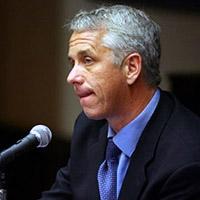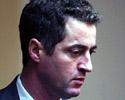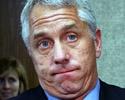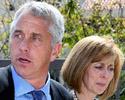News feature: Floyd Landis' arbitration hearing - day 4, May 18, 2007
Roller coaster day in Landis hearing
By Mark Zalewski in Malibu, California

|
What otherwise would have been another day of science-heavy testimony by LNDD chemists and a WADA accredited laboratory professor, was interrupted by the dramatic testimony of three-time Tour de France winner Greg LeMond. LeMond was called by the US Anti-doping Agency side to testify as to his phone conversation with Landis in August of 2006 -- a call which LeMond said Landis originated in response to LeMond's public comments about Landis' positive test from the Tour de France. However, even that testimony was turned on its head when LeMond revealed that he received a threatening phone call the night before testifying, allegedly from Landis' business manager Will Geoghegan, based upon the number that appeared on LeMond's mobile phone records.
After a recess, Maurice Suh, attorney for Mr. Landis, made a statement on the record regarding the relationship Mr. Geoghegan had with Mr. Landis, and that the relationship had just been terminated. "[Geoghegan] had served in the capacity as business manager at times prior to today," said Mr. Suh. "I'm still not sure exactly what the status was as of the last minute but we have decided to terminate all business relationships between Mr. Landis and Mr. Geoghegan as of today, as of right now."
Other than the statement for the record, the Landis side had no official comment, citing arbitration rules preventing them from speaking about the case. Mr. Geoghegan was called up to the witness stand by the USADA side, but was never questioned as the Landis lawyers stated that he had separate counsel that he should be allowed to consult prior to questioning. The USADA side agreed saying that that was going to be their first question. Mr. Geoghegan declined comment as he hurriedly left the building as the hearing resumed.
LeMond's testimony

|
Speculation had surrounded the case in regards to why the USADA side had called Mr. LeMond to testify. The listing of his title as a "three-time Tour de France winner" led many to believe that he would be speaking in the capacity as a former winner of the race. However, the USADA lawyer Matt Barnett instead focused on Mr. LeMond's public comments in reaction to the news about Landis' positive stage 17 test.
Barnett: Were you disappointed when you heard his A test was positive for exogenous testosterone?
Lemond: Yes I was, absolutelyBarnett: Did you make public comments about that expressing your dissapointment?
Lemond: I was inudated with requests. I did a few interviews. I would not put it that I was expressing disappointment, I was expressing that if it was a positive B sample that he would help the sport and come clean.
Barnett: Did Mr. Landis tell you why he was calling you?
Lemond: At first no, I didn't believe it was him. I was shocked that he called me. I thought it was a prank phone call...
...but I confirmed that it was really him. He asked why I would be making these public comments. The only reason they call me is when another American wins or is involved in a doping scandal. I raised my concerns that if it happened to a guy like Floyd that it would be devastating to the sport of cycling.Barnett: Did you give Mr. Landis some advice during that phone call that what he should do if he was involved in doping?
Lemond: I made it very clear that I did not judge that he did or didn't because his B sample was not positive at that time. I said I don't know if you did or didn't, but if you did, you can be the one to change the sport... salvage the sport. I would encourage you to come clean.Barnett: To the best of your recollection, what was his response to your encouragement for him to come clean?
Lemond: He said 'what good would it do?'

|
Next, Mr. Barnett referred to a story that Mr. LeMond said he told Mr. Landis - what he termed "a very personal story," that LeMond said he told to Mr. Landis in an effort "to encourage him."
Barnett: Was the point [of the story] to encourage him?
Lemond: It was to encourage him that he could help the sport and more importantly to help himself.Barnett: To the best of your recollection, what was his response?
Lemond: At this point he said, 'I don't see anything... what good would it do? If I did it would hurt a lot of my friends and destroy a lot of people.'
Next, Mr. Barnett directed his questions to an Internet message board posting that LeMond said was posted by Mr. Landis. A portion of the post said, "... if [LeMond] ever opens his mouth again and the word Floyd comes out, I will tell you all some things that you will wish you didn't know and unfortunately I will have entered the race to the bottom which is now in progress."
Barnett: He confirmed he personally had posted it?
Lemond: Yes.Barnett: What did you understand was the subject matter Mr. Landis was referring to?
Lemond: He was referring to the conversation on August 6, about my personal story to him about why he should come clean.
Following an offer by Mr. Barnett to tell the panel what he told Mr. Landis, but only if he felt comfortable in doing so, Mr. LeMond told his personal secret that he was sexually abused as a child. He further said he had told Mr. Landis this secret in an effort to encourage him to be truthful. "I shared it with him to show him what keeping a secret would do," LeMond said.
After this, Mr. Barnett brought the events of the night before, particularly the phone call, to light. Many shocked looks could be found among the gallery as the details were elaborated. When Mr. Geoghegan was identified as the caller, via a police report, he was asked to stand by the USADA lawyer.
Landis' side did have an opportunity to cross-examine Mr. LeMond. Howard Jacobs began his examination rather bluntly:
Jacobs: Did you ever use performance enhancing substances?
Lemond: No.
Soon after Mr. Jacobs began asking Mr. LeMond about his testimony in a civil lawsuit brought against Lance Armstrong by SCA Promotions back in 2005. Mr. LeMond's personal lawyer, Bruce Manning, who was present at the USADA team's table in the hearing room, objected to any question asked to Mr. LeMond regarding Mr. Armstrong, saying that it had no relevance to the hearing.

|
From there a back-and-forth between Jacobs, the USADA lawyers and the panel ensued - while Maurice Suh spent several minutes talking in Mr. Geoghegan's ear. Jacobs' main argument was that his questions regarding Mr. LeMond's testimony in the Armstrong case would go to establish motivation, and that if he were not allowed to ask these questions, Mr. LeMond's entire testimony should be stricken from the record.
The panel took a recess to confer and listen to further argumentation on the matter. However, upon returning, Mr. Jacobs continued his questioning regarding Armstrong - to which Mr. Manning summarily objected. After more deliberations the panel concluded that Mr. Jacobs could continue his cross about other questions, and that the questions regarding Armstrong, along with the motion to strike the entire testimony of Mr. Landis, would be decided later.
An arbitration rarity
One of the reasons the hearing is happening at Pepperdine University is that the school of law houses the Straus Institute for Dispute Resolution. Many professors from the law school, as well as the institute, have been observing the proceedings each day. One of the professors, Thomas Stipanowich, commented that the degree and flagrancy to which a witness was allegedly tampered with was for him "a rarity in arbitration. I've never had it teed up this way."
"I write a lot on arbitration law and I've never seen anything quite like this," he said. "I've had witnesses threatened before but not so overtly." Stipanowich went on to say that the panel can choose whether or not to include this evidence while rendering their decision, but also pointed out that the inclusion of the testimony is still up in the air. "The arbitrators are the judges of the relevance and materiality of all of the evidence. However, they are limited to civil remedies, so it would be a decision limited to the arbitration process such as the striking of the testimony of the witness, or possibly levying some other sanction."
As for Mr. Geoghegan, the panel has no authority with him beyond the scope of the case. However, a police report was filed and Mr. Geoghegan could be charged under California penal code - though it is unclear whether charges of witness tampering are specifically applicable in this instance.
Blinded me with science

|
The morning began with the USADA side calling Claire Frelat, the other LNDD analytical chemist that handled the Landis samples. After a brief cursory examination she was handed over to Maurice Suh for an in-depth cross-examination. Mr. Suh questioned Ms. Frelat along similar lines to what he asked of Ms. Mongongu the previous days - particularly regarding the chain of custody documentation and the IRMS machine logs.
Mr. Suh first focused on the chain of custody and the fact that it only shows when a sample is moved into a new room, such as for testing, and by whom. The Landis side seemed to want more detail, such as where the sample is located within the room and what is being done to and with it at all times.
Frelat: The transfer is not written, but it is written that at 11:03 I received the bottle. In order to do the [test] I have to have the bottle in my hand.
Suh: But where does it show that you actually received the bottle - the transfer from operator 18 to you? Find for me a document that shows how the sample moved through the laboratory for each of these tests?
Frelat: There is no registration to show how the sample is transferred. There are entries which pertain to who received the bottle, where and when.
One of the main points of contention along these lines for Mr. Suh, both yesterday and today, is the fact that the Landis samples were in the testing room at times for multiple hours even though the specific tests only normally take less than an hour.
Mr. Suh then transitioned over to the log sheet from the IRMS testing machine.
Suh: Prior to the time they were printed out, had you seen the log files?
Frelat: No.Suh: Did you work on the 5 January?
Frelat: No, that was a Saturday.Suh: Do you remember what happened in the time gap?
Frelat: I just counted the number of injections and that corresponds to the time I filled the liquid nitrogen.Suh: Is it written there that you did that?
Frelat: No, but I assumed I did.
May I explain? In order to do the analysis, we fill [the machine] with liquid nitrogen. Then we verify the peak center. When we verify it is good, we start the stabilisation. I had forgotten to verify the peak centre. When I realized I then verified the peak centre. In order to verify the peak centre you have to open up the CO2 valve in order to do the peak centre. Then you have to close the valve. I had forgotten to do that on the second one. Which means I closed the valve and then performed the stabilsation. It caused me to lose time.Suh: So it caused you to lose three minutes?
Frelat: Well, I'm not sure I like how you say it.Suh: You began the automatic sequence, and as it is running you didn't realise until the end of three that they were in the wrong place. Then you went back, stopped the process, then you went back and put three new [injections] in the right place and ran it again?
Frelat: Yes, I replaced the vile into the correct position.Suh: Why at that point didn't you save it to a new file name so everyone would know what happened?
Frelat: That is just the way I did it.Suh: So absent your testimony today, that is the only way we would know what happened here?
Frelat: Yes.Suh: In other words, if someone were to say the reason that these mixCal IRMS are rerun and saved with the same file name was because you saw results you did not like and re-saved over it. The only way we would know that that didn't happen is your memory of what occured on that day. Is that right?
Frelat: Yes.
Next, Mr. Suh turned to Ms. Frelat's stage 17 B sample analysis:
Suh: You said you were involved in the testing of the blank and the actual sample?
Frelat: Yes.Suh: When you did the first analysis, did you use the OS2 automatic background subtraction feature?
Frelat: When the report was drawn up I would always verify the estimate of the background noise and the integration of the peaks?Suh: And you would do that manually?
Frelat: Yes.Suh: You are choosing where the peaks begin and where they end?
Frelat: Yes.Suh: Your SOP says you have exercise care in picking where the peaks begin and end because it can have a dramatic impact on the isotopic value of the results?
Frelat: Yes, it is written that we must be very careful but not that it will have dramatic consequences or that it will affect the results in a dramatic way. It is written that it could have a significant change in the results.Suh: What do you believe is a significant difference in carbon isotope testing for your final per mil value?
Frelat: A difference of 1.5 or 1.6 per mil.Suh: You are aware that LNDD would report an adverse analytic finding (AAF) whenever there is a greater than negative 3 per mil difference?
Frelat: Yes.Suh: So 1.5 or 1.6 is half of that? Can you point to a SOP where it defines a significant difference as 1.5 of 1.6?
Frelat: It is not written, my answer was concerning my opinion.Suh: Of course, you were trying to do your very best job?
Frelat: Yes.Suh: You are saying that the ones that are close, are close enough?
Frelat: Yes.Suh: Are you saying those pages document your choices of where the peaks are for the stage 17 analysis?
Frelat: This is the report of the results which I have found.Suh: Is there a report of how you came to that conclusion of where the peaks begin and where they end?
Frelat: We do not print any reports that show the 44/45 trace. We only have the final report after we have done the work and the chromatogram with the highest ion.Suh: For stage 17, did you use manual subtraction?
Frelat: Yes, I just said that.
Ms. Frelat was much more assertive in responding to Mr. Suh's questioning, at times giving him noticeable looks bordering on disdain. The day concluded with testimony by Dr. Christine Ayotte, professor and director of a WADA accredited laboratory. Much of her testimony was used to analyse the testimony of the two LNDD technicians.
Mr. Jacobs began his cross-examination with references to two articles in which Dr. Ayotte was quoted regarding her opinions of athletes evading doping sanctions and specifically the Landis case.
Chicago Tribune article, 10/13/06
"A few boo-boos in hundreds of pages of documents is not enough to say the case foes into the wastebasket."
"I would say I was referring to typographical errors in the documents," said Dr. Ayotte in response to Mr. Jacobs' questioning. Mr. Jacobs continued questioning Dr. Ayotte regarding items such as the chain of custody and the procedures of the IRMS analysis - focusing on the validation of methods of the IRMS test, such as problems with matrix interference, carryover from sample to sample, and identification capability.
Jacobs: You would agree that a positive result is only as good as the chromatography?
Ayotte: Yes.Jacobs: You have no personal knowledge how LNDD ran their analysis?
Ayotte: No.Jacobs: If the log files show that LNDD stopped in the middle of the sequence to fix something, would that concern you?
Ayotte: No.Jacobs: And you don't document that at all?
Ayotte: No.Jacobs: And you don't document that at all?
Ayotte: No.
The questioning of Dr. Ayotte went on to refer to the testimony of the two LNDD employees from earlier -- focusing on the sequences when they made changes to the sequence, resulting in the log file to be overwritten. "That the results provided are supporting the conclusion reached by the lab," Dr. Ayotte said. "What the lab has done before, whether they changed the liner or override the calibration standard, is absolutely of no relevance. I'm only focusing on the set-up of the instrument to ensure the quality. We are not talking about the athlete samples, we are talking about the controls on the machine."
With that the day concluded. Tomorrow's expected witnesses include:
Dr. Christiane Ayotte, PhD
Professor. Director Montreal WADA Accredited Laboratory
Dr. Corinne Buisson
IRMS Supervisor, LNDD
Joseph Papp
Professional Cyclist
Dr. Bruce Goldberger, DABFT
University of Florida, Director of Toxicology and Professor
Photography
For a thumbnail gallery of these images, click here
Images by AFP
- Greg LeMond testifies during the Floyd Landis USADA arbitration hearing
- Will Goeghegan manager of Floyd Landis, lost his job because of the phone call
- LeMond leave the building with his wife Kathy after testifying in the Landis hearings
- Greg LeMond is mobbed by reporters after his shocking testimony
- Greg LeMond speaks to reporters after testifying that he was threatened by phone the night before his testimony by Landis' manager
Images by Mitch Friedman/www.mitchophoto.com
- LeMond shows the call history on his phone as evidence of the alleged call made by Landis' associate Will Geoghegan. (Note: Cyclingnews has digitally edited this image for legal and privacy reason)
Cyclingnews' coverage of the Floyd Landis case
May
29, 2009 - French authorities summon Landis and Baker
September 28, 2008 - Landis
takes case to US federal court
September 10, 2008 - Landis
signing with current Health Net-Maxxis team for 2009
July 1, 2008 - CAS
delivers final blow to Landis legal challenge
June 30, 2008 - Landis
loses final appeal
June 28, 2008 - Landis
decision due Monday
March 12, 2008 - Landis'
judgment day nears
October 21, 2007 - Landis
files appeal with CAS
October 18, 2007 - AFLD
takes another look at Landis case
Thursday, October 11 -
Landis continues fight, appeals to CAS
Saturday, September 22
- UCI officially names Pereiro 2006 Tour champion, Landis case raises issues
Friday, September 21 -
Landis' appeal denied, two year suspension levied

